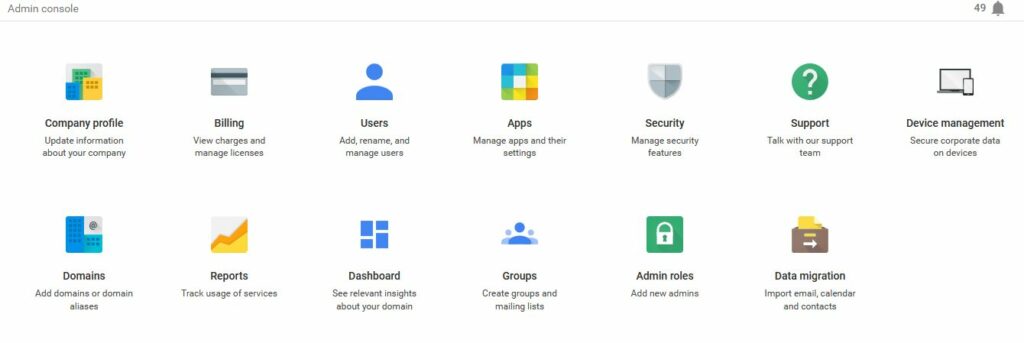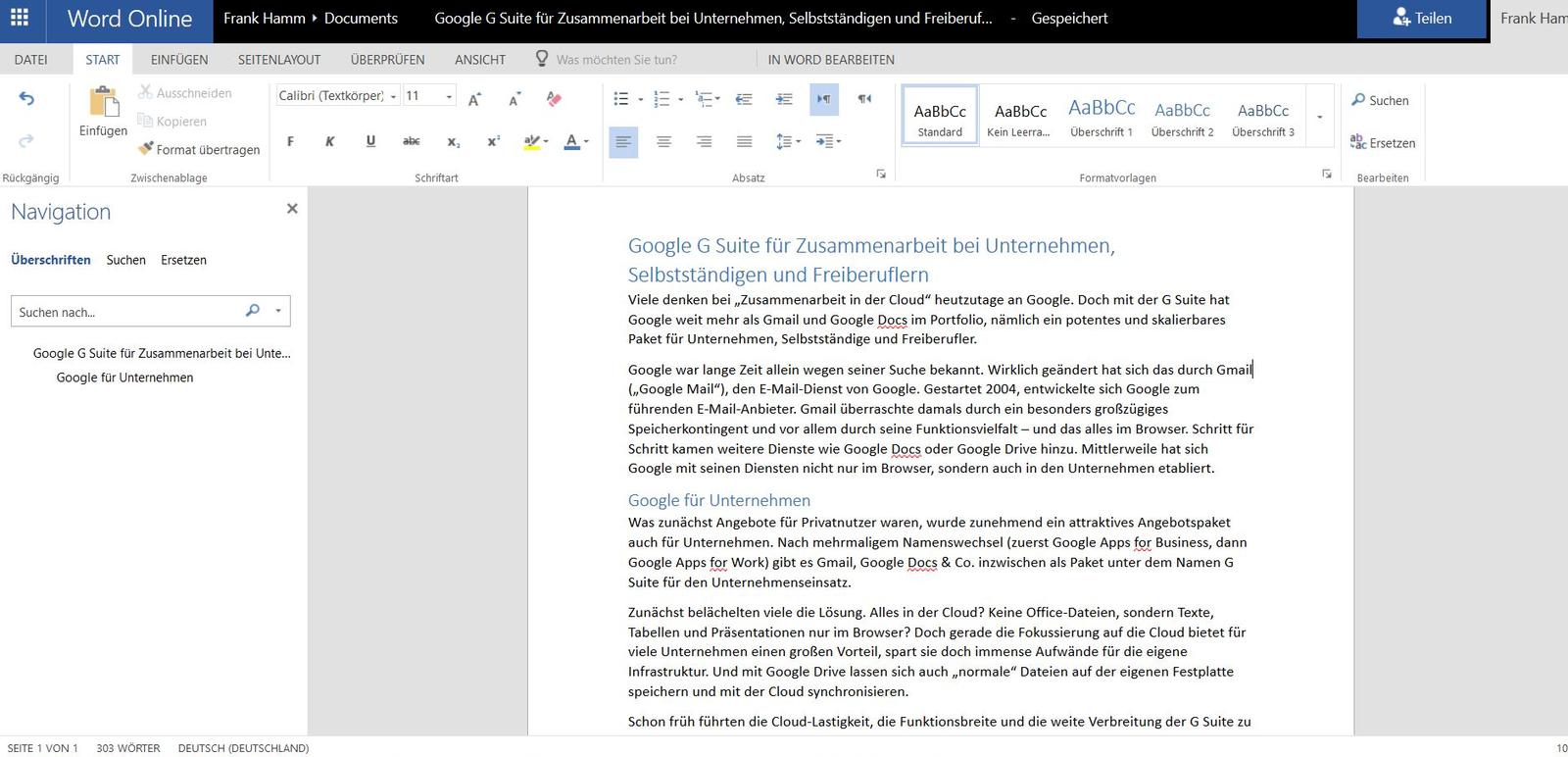Any plan to quickly compare G Suite and Office 365 is doomed to fail from the outset. In my experience, the two products cannot be compared with a simple table and a checklist of functions. The applications (apps) in the two competing product suites are too many, their features are sometimes too different - plus the variety of use cases and how you can use them in different ways to reach different goals in most companies are simply too diverse.
If you look at just the traditional applications of a word processor (documents) or a spreadsheet program (tables), a comparison is quite easy. But when you start comparing Google's Keep and Microsoft's OneNote, it becomes clear there are very different philosophies driving the two companies. To make it even harder, there are many ways you can combine apps within the product suites, using them together to complete specific tasks.
Different philosophies
The product suites clearly show their beginnings. Google's G Suite began in the Cloud and always had tight links between its online applications. Office 365 came from applications traditionally installed on desktops, as well as server-based enterprise software like SharePoint, and the newly-develops apps add to this collection.
Early on, Google moved to its maxim of simple administration and simple applications in the browser or in lightweight apps.

G Suite Admin Console
Microsoft struggled for many years to consolidate different software applications and philosophies. Plus, complex custom packages of Microsoft products were developed to satisfy the requirements of as many companies as possible. Both of these issues are often still visible in Office 365's administration and apps. Microsoft has simplified a lot in recent years (for example in the administration interface). However, administrators still need to use the command line(such as PowerShell for SharePoint in Office 365) to make changes to its configuration.

Office 365 Admin Center
You could say the two philosophies are as follows:
- Google makes it easy.
- Microsoft makes it possible, but not necessarily easy.
Targetted marketing
G Suite and Office 365 target similar customers and have similar marketing approaches. Google describes their G Suite:
G Suite provides all you need to do your best work, together in one package that works seamlessly from your computer, phone or tablet.
G Suite provides tools for:
- Communication ("Reach your colleagues wherever they are.")
- Collaboration ("Everything you need to bring your project to life.")
- Storage space ("Store files and find what you need instantly.")
- Administration ("Manage users, devices, and data securely and easily.")
Microsoft describes Office 365 similarly:
Your place to create, communicate, collaborate, and get great work done.
If you look at the marketing for Office 365, it could be describing G Suite, even if Microsoft's descriptions are a little cumbersome:
- "It's the apps you know and love."
- "It's always up to date."
- "It's on all your devices."
- "It's your great work, in the cloud."
Ultimately, both product suites are about communication and collaboration both within your company and with external parties, such as customers, suppliers, and partners.
Pricing
Both product suites, G Suite and Office 365, are available with similar pricing models. Both are flexible cloud-based software subscriptions. Both application suites can be used within a browser and with simple, small apps (like on a smartphone or minimal desktop clients). Office 365 offers a pricing option with traditionally installed software for desktop computers (for example Powerpoint or Skype for Business).
Google has a fairly simple pricing scale for G Suite, whereas Microsoft differentiates between "small businesses" with up to 300 users, and enterprise rates for an unlimited number of users.
Pricing for both product suites differs based on the applications they contain as well as the administration, security and compliance features you choose to include. You can choose to allow your G Suite users to use the free Google products privately (configurable in the Admin Center).
G Suite pricing for companies (price per user per month, monthly subscription)
- Basic ("Professional office suite with 30GB storage"): 5 USD
- Business ("Enhanced office suite with unlimited storage and archiving"): 10 USD
- Enterprise ("Premium office suite with advanced controls and capabilities"): 25 USD
Office 365 pricing (price per user per month, yearly subscription):
- Tarife für Unternehmen: ProPlus (12 USD ), Enterprise E1 (8 USD), Enterprise E3 (20 USD) und Enterprise E5 (35 USD).
- Tarife für kleine Unternehmen: Business (8.25 USD), Business Premium (12.50 USD, or 15 USD paid monthly), Business Essentials (5 USD, or 6 USD paid monthly).
Plus, both G Suite and Office 365 have marketplaces where you can add apps and extensions from third parties.
It's impossible to find a comparable combination of pricing and included apps (scope and features) that is 1:1. G Suite Business and Office 365 Business Premium have similar features at a similar price point. However, Office 365 Business Premium, for example, only allows 300 users, but includes a local desktop installation of Office applications in addition to a "Mini CRM system" with its Outlook Customer Manager.
I'd like to give you a broad comparison of the main components of the two product suites. Because of the wide range of pricing packages, I can not go into detail or give you a comprehensive comparison.
Office: documents, spreadsheets, presentations, databases
- G Suite: Docs, Sheets and Slides in your browser (or using mobile apps).
- Office 365: Word, Excel and Powerpoint in your browser (or as mobile apps), and depending on the package you subscribe to, desktop applications and databases.
Both G Suite and Office allow you to assign permissions (to specific users or via a shareable link), and support multi-user editing, versioning and comments.

G Suite Docs
Personal organization: email, calendar, tasks
- G Suite: Gmail, Calendar, and the Tasks feature built into Gmail and Calendar (browser-based and mobile apps).
- Office 365: Outlook (browser-based and mobile apps, and depending on your pricing package, also available as a desktop application).
Both product suites allow you to set permissions for other users with Mail and Calendar.
Chat, video conferencing and team management
- G Suite: Hangouts Chat for individuals and groups (within the company), Hangouts Meet (video conferencing).
- Office 365: Skype for Business, Microsoft Teams.
Last year, Microsoft introduced Microsoft Teams, which will eventually replace Skype for Business (formerly Lync). Teams also includes other components of Office 365 such as the Planner (team-based task planning and processing), files, and a wiki.
Data storage
- G Suite: Google Drive
- Office 365: OneDrive for Business, SharePoint
Both product suites offer synchronized desktop and mobile clients. If you want to synchronize files only on demand, you can only do this with G Suite's "Drive File Stream" and Office 365's "Files On Demand".
G Suite provides 30 GB in its Basic subscription package, but unlimited storage space in its Business and Enterprise packages. , With Office 365, you'll get 1 TB when you subscribe to the Small Business, ProPlus, and Enterprise E1 packages, or unlimited space with the larger packages.
You can create a knowledge base with SharePoint and Office 365.
Notes
- G Suite: Keep (browser-based and mobile app).
- Office 365: OneNote (desktop client, browser-based and mobile app).
Both product suites can be used to record, share and manage content and ideas. G Suite's Keep does require the Chrome browser to work smoothly.
The rich feature set of OneNote in Office 365 is in stark contrast to the simple collaboration on notes with G Suite.
Websites
- G Suite: Sites (for internal and public websites).
- Office 365: Public and internal websites based on SharePoint.
You can create extensive websites and applications based on SharePoint (Office 365). But you will need to be an experienced SharePoint developer.
Social network
- G Suite: Google+
- Office 365: Yammer
Both product suites let you use their respective social networks both internally and publicly. Google+ is seamless to use with external parties as it is already available as a public social network. Using Yammer, you can create a social network that can be accessed by external users.
Additional features
G Suite
- Google Jamboard for collaboration on a whiteboard (available with all packages)
- EMail and chat archives, data retention policies (Business and Enterprise packages)
- E-Discovery (Business and Enterprise packages)
- Data loss protection (Gmail, Drive) (Enterprise package only)
Office 365
- Planner for collaborative task planning and processing (based on Kanban)
- Sway for visually attractive newsletters, presentation and documentation
- StaffHub for schedule management and information sharing (Business Premium and larger packages)
- Data retention and deletion policies (Enterprise packages)
- Analyses and Business Intelligence with MyAnalytics and Power BI Pro (Enterprise packages)
- eDiscovery including search, analysis, export and character recognition within images (Enterprise packages)
- Flow for automated workflows between apps and services
- PowerApps for creating apps linked to local or cloud data
Conclusion
This attempt to compare pricing and included applications shows that it is more than difficult to compare G Suite and Office 365 packages without taking into account your company's requirements. Due to the variety of features and packages, companies cannot avoid doing a requirements analysis first, and then start to compare the applicable pricing packages with each other.
Lesen Sie diese Seite auf Deutsch
Frank Hamm
You can find more articles by Frank Hamm in our intranet special.



